Michael Rakowitz & Ancient Cultures
A Trilogy of Exhibitions Bridging Ancient Cultures and Contemporary Art
A collaboration between the Hellenic Ministry of Culture, the Acropolis Museum, the Ephorate of Antiquities of Athens, and NEON
This collaboration between the Hellenic Ministry of Culture, the Acropolis Museum, the Ephorate of Antiquities of Athens, and NEON Organization initiates a deep and meaningful dialogue between contemporary works and ancient artefacts. This partnership underscores enduring themes of cultural heritage, loss and restitution, survival, and the ongoing creation of culture. The result is a trilogy that unfolding during 2025 and 2026.
At its core is the multidimensional work of internationally acclaimed contemporary artist Michael Rakowitz whose art engages with ancient Greek antiquities and artefacts from ancient civilisations of the southeastern Mediterranean and the Middle East. The trilogy starts in 2025 at the Acropolis Museum, continues in the museum’s western exterior area leading to Mitseon Street, and concludes in 2026 at the Old Acropolis Museum on the Acropolis Hill.
The power of this collaboration between archaeology and contemporary art lies in its capacity to challenge dormant or seemingly distant historical narratives. Ancient exhibits are shown in a new light through interventions of recent works that contextualise the complexity and continuity of cultural heritage, interweaving diverse experiences, identities, and memories. This initiative is an urgent call to preserve humanity’s shared cultural history at the same pace at which it is being lost.
The trilogy represents a dialogue rich in concepts, emotion, and political resonance – deeply relevant to our times. The works recall recurring traumatic historical events – war, looting, theft, colonialism, and migration – while drawing attention to the present-day fate of war-torn regions and the forgotten journeys of displaced peoples and cultural treasures. The trilogy unites classical and contemporary cultures of this region within the Acropolis Museum, extending to the Rock of the Acropolis and the Parthenon, an emblem of Western civilisation. It represents the dynamic interplay of civilisations that have shaped both the classical and modern worlds.
Lina Mendoni, Minister of Culture, states: ‘The collaboration between the Hellenic Ministry of Culture and NEON has consistently demonstrated its value in recent years. Contemporary artworks are placed at carefully chosen archaeological sites,in a constructive dialogue, enriching the continuity and timeless depth of Greek culture. Our collaboration on this trilogy is even more robust and focused. A remarkable civilisation – that of the Assyrians, among the oldest of the Mediterranean civilisations – enters into a harmonious dialogue and creative synergy with Greek antiquities and with the modern creations of Michael Rakowitz, who draws inspiration from the biblical kingdom of ancient Assyria and its enduring masterpieces of Mesopotamian art. Tragically, some of these works have only recently suffered looting and destruction.Many, either intact or in fragments, were stolen and violently removed from the places that created them. Beyond all the other multiple meanings of the trilogy, it directly alludes to the destruction and violent seizure of the Parthenon Sculptures.Our political priority is to foster the fusion of cultural heritage and contemporary creativity, and to amplify the outward reach of Greek culture. These priorities are fully embodied in this collaboration of the Ministry of Culture and NEON. I especially thank Dimitris Daskalopoulos for his steadfast creative partnership and generosity. Michael Rakowitz’s inspired creations, serve as a unified thread for this trilogy. Warm congratulations to the exhibition curators – Professor Nikos Stampolidis, Director General of the Acropolis Museum, and Elina Kountouri, Director of NEON – for this outstanding exhibition of multiple meanings at the Acropolis Museum. I also thank the Ephorate of Antiquities of the City of Athens and its head, Elena Kountouri and the Ministry’s officials for their exceptional work at the Old Acropolis Museum, which will reopen to the public in 2026 with three new exhibitions.’
Dimitris Daskalopoulos, Founder of NEON, adds:
The collaboration between NEON with the Ministry of Culture, the Acropolis Museum and the Ephorate of the City of Athens marks our long-term engagement with contemporary art and heritage. My interest lies in exploring and supporting new methods of civic engagement and I believe that the work of Michael Rakowitz in relation to ancient cultures will support our consistent efforts to make art more accessible to a wider local and international public and its ideas more impactful. I extend my heartfelt thanks to the Hellenic Ministry of Culture, Minister Lina Mendoni, the Acropolis Museum Board of Directors and its Director General, Professor Nikolaos Stampolidis and, of course, to Michael Rakowitz.
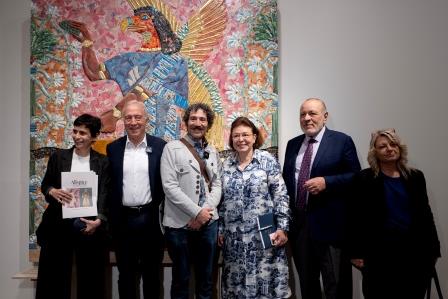
First part: Collaboration between the Acropolis Museum and NEON
Exhibition Title: Allspice | Michael Rakowitz & Ancient Cultures
Curated by: Professor Nikolaos Chr. Stampolidis, Director General of the Acropolis Museum and Elina Kountouri, Director, NEON
Acropolis Museum, Temporary Exhibition Gallery
13 May–31October 2025
The first part of the trilogy is the exhibition Allspice | Michael Rakowitz & Ancient Cultures, curated by Professor Nikos Stampolidis, Director General of the Acropolis Museum, and Elina Kountouri, Director of NEON. It will be presented in the Temporary Exhibition Gallery of the Acropolis Museum from 13 May to 31 October 2025.
Contemporary works by Michael Rakowitz will be shown alongside ancient artefacts from the University of Chicago’s Institute for the Study of Ancient Cultures and the Thanos N. Zintilis Collection of Cypriot Antiquities at the Museum of Cycladic Art, Athens. Together, these elements interweave narratives that speak to both our past and present. The exhibition also features three new commissions by the artist.
Set in the Acropolis Museum’s Temporary Exhibition Gallery – where the absence of the Parthenon sculptures is acknowledged – the exhibition unfolds a story of colonialism and the looting of cultural institutions, as viewed through Rakowitz’s lens. The artist addresses a persistent global and still unresolved cultural trauma: the displacement of objects that embody the memory and identity of a people, transforming them into artefacts in exile; as well as products of looting, theft, transaction, destruction and disappearance.
The exhibition’s title, Allspice, inspired from handwritten recipes by Rakowitz’s mother, reproduced on the existing columns in the rooms of the temporary exhibition space. It evokes cross-cultural interactions and the memories of exile and migration – of both people and their cultures. The installation, a new commission by NEON, reflects Rakowitz’s personal and political engagement with diasporic identity. As he explains: ‘Going through my mother’s Iraqi recipes, one of the ingredients that is the most ubiquitous is allspice. This unripe dried berry, ground into a powder, tastes like many things all at once: cinnamon, cloves, nutmeg, hints of cardamom. It features as one of the major ingredients and dominant flavours in Iraqi baharat (spice mix) and when one is unable to procure all the other spices, it serves as a good substitute and preserves the flavour profile of the recipe.’
‘Substitute is derived from the Latin substituere, which comes from statuere, whose noun derivative is statua, or statue, which seems central to my work as a sculptor for the past two decades: making sculptures that are substitutions for other sculptures that have disappeared or been destroyed.
The exhibition opens with Rakowitz’s video work The Ballad of Special Ops Cody, filmed at the Assyrian Galleries of the Institute for the Study of Ancient Cultures Museum (ISAC Museum) in Chicago. In it the toy figurine Special Ops Cody offers to liberate the statues, urging them to escape from their vitrine and return home.
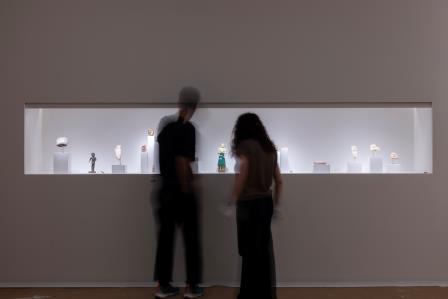
The exhibition presents ancient artefacts from the Middle East and southeastern Mediterranean, generously on loan: thirteen artefacts from the University of Chicago Institute for the Study of Ancient Cultures, and one from the Thanos N. Zintilis Collection of Cypriot Antiquities. These are shown in dialogue with many contemporary works from Rakowitz’s long-running series The invisible enemy should not exist). The works from the series The invisible enemy should not exist/ Northwest Palace of Kalḫu (Nimrud) are ‘reappearances’ of relief sculptures from the Northwest Palace of Kalhu (Nimrud) – historic Assyrian artworks that were looted or recently destroyed. These ‘reappearances’ are presented with empty spaces between them, echoing the damage of antiquity, war, and looting. Rather than concealing these cracks, the works embrace them, transforming trauma into testimony and absence into presence
These works are made of papier mâché using Middle Eastern food packaging, Nineveh Magazine, published in Modern Assyrian and English, and Arabic-English newspapers found throughout the US, and bear deliberate visual absences and gaps. These disposable materials underscore the absence of the original objects that are missing.
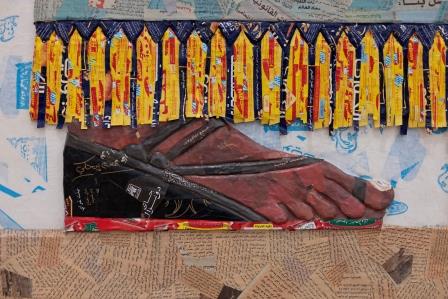
Professor Nikolaos Chr. Stampolidis, Acropolis Museum General Directorand co-curator of the exhibition, mentions: ‘In any discussion about antiquities, one should insist on a fundamental distinction: are they refugees or prisoners?
If artefacts are considered refugees, forcibly removed from their homeland due to circumstances beyond their control, then one could argue that they should be repatriated whenever conditions allow for their safe return. This repatriation, however, should not be linked to acts of theft, plunder, or trade. On the other hand, if they were forcibly expatriated through illegal means like grabbing, trading, bribery, etc., for personal enrichment, then the captive antiquities should be returned to their rightful owners.
Until restorative Justice is achieved, Rakowitz’s works, whether they are whole or fragmented statues, architectural components, or other forms of ‘reappearances,’ remain shadows and ghosts of the original objects, bearing the scent of memory and humanity. They serve as a poignant reminder of the thousands of objects that have been transported from exhibition to exhibition, from country to country, sensitizing consciences until the intended restoration of justice.’
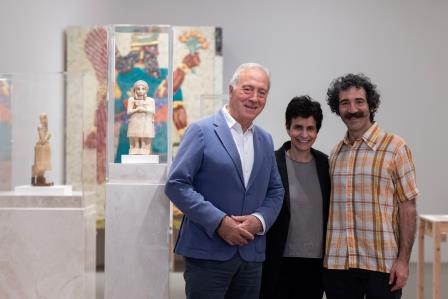
Elina Kountouri, Director of NEON and co-curator of the exhibition, adds:
‘Rakowitz’s artistic language is highly personal yet has a universal reach as if, through his attempt to save Iraq’s cultural history, he is offering us a history of the world. He metabolizes wartime devastation in his work by returning to the objects themselves: whether lost, missing, or imperfect. He is making them whole again but not by ‘reconstructing’ them, a term that he emphatically resists. Instead, he advocates the term ‘reappearance’ as a recurring motif in his work. The production of these objects as artworks forms part of our material and immaterial heritage. They remain relevant, as they remind us of lives once lived and the survival of cultures.’
‘Allspice is more than a contemporary art exhibition in dialogue with antiquity. It’s about our precarious condition in the present and the language of survival. By joining forces, maker and viewer ensure that wars are remembered and acknowledge transgenerational trauma, loss, and absences.
Within the wall of the Acropolis Museum this storytelling becomes as much an act of healing as of resistance.’
The second new commission, in the exhibition, titled A Baghdadi Amba Dictionary, appears within a display dedicated to multiple times and cultures. It is connected to the Chicago Assyrian Dictionary (CAD) and speaks to the fragility of language and cultural heritage.
The CAD is a monumental scholarly project. This 21-volume encyclopedic study of Akkadian, a language not spoken for 2,000 years, was compiled by scholars at the Institute for the Study of Ancient Cultures of the University of Chicago. It provides a comprehensive record of Akkadian, the earliest known Semitic language, written using the cuneiform script. Its lexical entries quote individual cuneiform sources from different regions and periods—spanning some 2,500 years and multiple dialects—revealing shifts in meanings and usage of Akkadian words and consequently of Mesopotamian society and culture.
As an indispensable research tool, the CAD not only allows scholars to explore the written record of Mesopotamian civilization but also contributes to the study of later Semitic languages, including modern Assyrian (also known as modern Syriac or Northeastern Neo-Aramaic), tracing linguistic and cultural connections that extend into the present day.
In A Baghdadi Amba Dictionary, Rakowitz draws a parallel between the vulnerable state of cultural relics and the fragile memory of diasporic communities. The scholar reviving a forgotten language and the conservator restoring a damaged manuscript both face dilemmas akin to those of the expatriate who must reconcile inherited identity with life in a new homeland. What do we preserve? What do we let go? How do we safeguard what is fading? How do we hold together a fragmented sense of self?
Ambais a pickled mango condiment originating in India, that features quite prominently in Iraqi cuisine and is believed to have been first imported there in the 19th century. In Chicago, it is sold at Assyrian grocery stores. A Baghdadi Amba Dictionarycomprises preserved jars of amba have been homemade here in Athens by the artist Michael Rakowitz and will be served at the conclusion of the exhibition. On the outside of each jar, Rakowitz has inscribed on the glass a meandering glossary of terms and expressions that his Iraqi Jewish mother, Yvonne, has taught him over the years, preserving a dialect in diaspora.
In the third new commission, Michael Rakowitz creates a collage between cultures, “linking” the body of the. The work titled Study for a Lamassu in spoliafeatures a sketch of the body of the lamassu drawn directly on the glass of the vitrine containing the stone male head from Cyprus, from the Thanos N. Zintilis Collection of Cypriot Antiquities in the Museum of Cycladic Art in Athens. The work proposes a possible union of these two fragments, often seen in spolia, an ancient technique in which stones from older structures were repurposed for functional or decorative purposes.
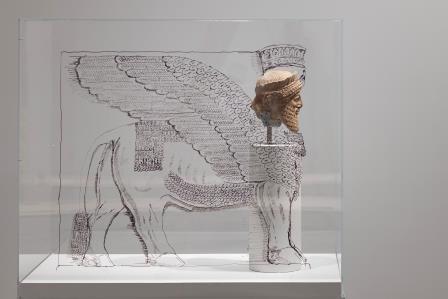
Michael Rakowitz states: ‘Over the past three years planning these projects with NEON and the Acropolis Museum, I have been so lucky to travel to Athens again and again. Each time, I have anticipated with excitement my arrival in this amazing city, and I weep when I depart. Truly, I have become homesick for Athens, a place that has embraced me, and I have embraced back. As the child of a father who is a doctor devoted to healing and mending the breached and the broken, and a Baghdadi Jewish mother who continues to pass on her culture to her sons and her grandchildren, I deeply connect to the local histories of displacement and restoration. The Acropolis Museum itself, where the exquisite parts of the Parthenon are exhibited while the other half has been violently removed, has been such an inspiration, as it has taught me so much and has opened further understanding for me about my own work. To be able to exhibit my work here leaves me speechless, as it overlaps and connects not only through the past but opens windows into a future where objects and people can be reunited. With love, I say, efcharisto. Thank you for inviting me here.’
Second part: Collaboration between the Acropolis Museum and NEON Organization
Lamassu of Nineveh(2018) | Michael Rakowitz & Ancient Cultures
Curated by: Professor Nikolaos Chr. Stampolidis, General Director of the Acropolis Museum and Elina Kountouri, Director, NEON
Acropolis Museum, Sculptural Installation |Exterior surrounding area of the Acropolis Museum, west wing
October 2025–December 2026
In October 2025, the second part of the exhibition Michael Rakowitz & Ancient Cultures will feature the public installation of The invisible enemy should not exist/ Lamassu of Nineveh (2018), on the western side of the Acropolis Museum, facing Mitseon Street. Originally commissioned for the Fourth Plinth in London’s Trafalgar Square, the work is a major sculptural extension of Rakowitz’s ongoing series The invisible enemy should not exist. Constructed from empty cans of Iraqi date syrup, the sculpture reconstructs the protective Assyrian deity Lamassu – a colossal 4,3 meters winged bull with a human face that once stood at the entrance of the Nergal Gate in ancient Nineveh. The original monument, dating from around 700 BCE, was destroyed in 2015 by ISIS along with many other artefacts in the Mosul Cultural Museum.
The Athens installation brings the Lamassu into an immediate dialogue with multiple layers of history and memory: the archaeological excavation visible beneath the museum, the sacred landscape of the Acropolis above, the modern city around it, and the contemporary architectural space of the museum itself.
Third part: Collaboration between the Ephorate of Antiquities of Athens of the Ministry of Culture and NEON Organization
Old Acropolis Museum
Acropolis Hill
May 2026–December 2026
The final part of the trilogy opens in May 2026 with an exhibition at the Old Acropolis Museum, on the Acropolis Hill a collaboration between the Ephorate of Antiquities of the City of Athens of the Ministry of Culture and NEON. This final chapter explores stories of diaspora and how objects – originating from diverse historical, geographical, and archaeological contexts – come together to form layered narratives. These narratives extend beyond physical geography to encompass historical and cultural dimensions. At the centre of this new commission is the brick: a symbol of construction, memory, and storytelling and the soil used to make it becomes a material link to place and identity.
First part: Collaboration between the Acropolis Museum and NEON Organization
Exhibition Title: Allspice | Michael Rakowitz & Ancient Cultures
Acropolis Museum, Temporary Exhibition Gallery
13 May–31 October 2025
Opening hours:
Monday 9am–5pm
Tuesday–Wednesday–Thursday 9am–8pm
Friday 9am–10pm
Saturday–Sunday 9am–8pm
Free Entrance with a free entry ticket from the Acropolis Museum’s ticket counters.
Group bookings (from 15 to 30 people) are made via email at This email address is being protected from spambots. You need JavaScript enabled to view it..
Guided tours of the exhibition, led by the Museum’s archaeologists, begin on Sunday, May 18, and require an online reservation.
More information: https://www.theacropolismuseum.gr/thematikes-paroysiaseis/allspice-michael-rakowitz-ancient-cultures
Information at neon.org.gr & theacropolismuseum.gr
Plus article in ekathimerini.
Notes to Editors
Michael Rakowitz (b. 1973, Great Neck, New York, USA) is an Iraqi-American artist working at the intersection of problem-solving and troublemaking. Rakowitz explores the displacement of communities and cultural heritage caused by war and imperialism, activating everyday objects and employing unconventional approaches. He lives and works in Chicago US, and he is a Professor of Art Theory and Practice in Nothwestern University, IL.
His work has appeared in venues worldwide including dOCUMENTA (13); P.S.1; MoMA and Tate Modern, among others. He was awarded the 2018-2020 Fourth Plinth commission in London’s Trafalgar Square. From 2019-2020, a survey of Rakowitz’s work traveled from Whitechapel Gallery in London, to Castello di Rivoli Museo d’Arte Contemporanea in Torino, to the Jameel Arts Centre in Dubai. He was recently granted a commission on the topic of Archaeology and Migration Flows for the Municipality of The Hague.
NEON is a nonprofit organization that works to bring contemporary culture closer to everyone. It is committed to broadening the appreciation, understanding, and creation of contemporary art in Greece and to the firm belief that this is a key tool for growth and development.
NEON, founded in 2013 by collector and entrepreneur Dimitris Daskalopoulos, breaks with the convention that limits the contemporary art foundation of a collector to a single place. NEON’s space is the city. It acts on a multitude of initiatives, spaces, and civic and social contexts. It seeks to expose the ability contemporary art has to stimulate, inspire, and affect the individual and society at large.
NEON constructively collaborates with cultural institutions and supports the programs of public and private institutions to enhance increased access and inventive interaction with contemporary art.